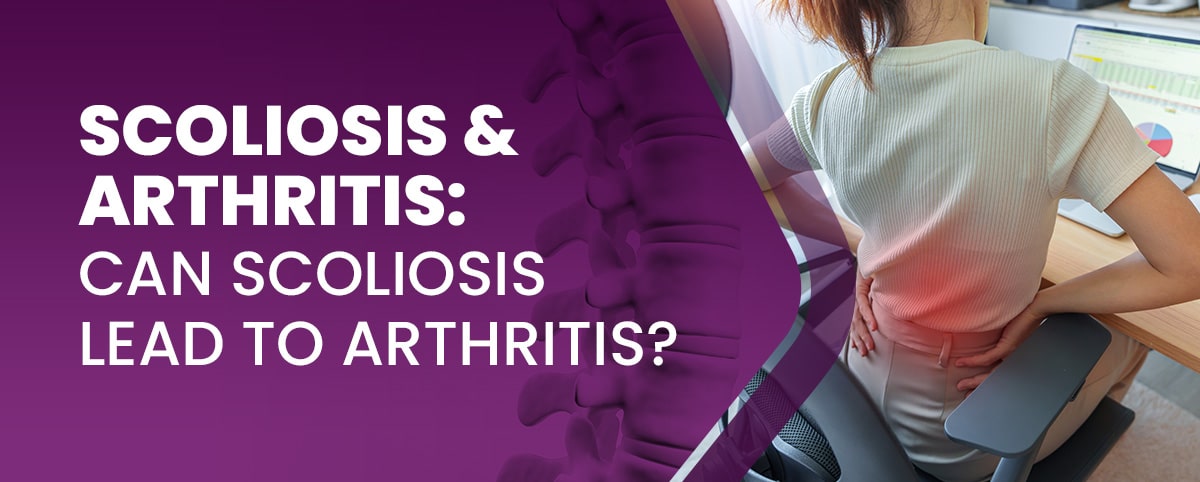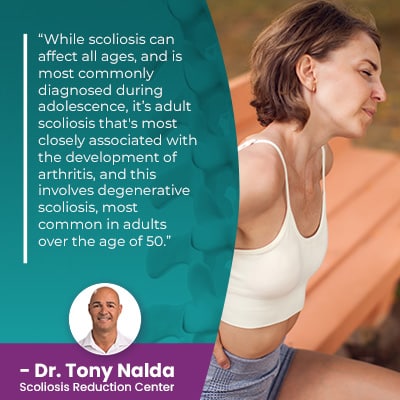Scoliosis & Arthritis: Can Scoliosis Lead To Arthritis?

Scoliosis is the development of an unnatural sideways spinal curve, with rotation, and as the spine bends and twists unnaturally, it can affect the spine, and its surroundings, in a number of ways. Scoliosis can disrupt spinal health and function, and this can cause it to wear unevenly, and degenerative scoliosis can contribute to the development of osteoarthritis of the spine.
Degenerative scoliosis and osteoarthritis of the spine share the same degenerative process, and osteoarthritis is the most common type of arthritis. Scoliosis introduces uneven forces to the spine and its surroundings, and this can lead to arthritis of the spine.
Before exploring the specific connection between scoliosis and arthritis, let’s first define each condition.
Table of Contents
What is Scoliosis?
Scoliosis is a structural spinal condition that causes the development of an unnatural spinal curve.
A scoliotic curve bends unnaturally to the side and also rotates, making it a 3-dimensional condition.
In addition, a scoliotic curve has to be of a minimum size to be diagnosed as scoliosis: a minimum Cobb angle measurement of at least 10 degrees.
A patient’s Cobb angle is determined during X-ray by measuring the most-tilted vertebrae at the apex of the curve, and the resulting angle is expressed in degrees and tells me how far out of alignment a patient’s spine is.
When the spine’s healthy curves are in place, the vertebrae (bones of the spine) are stacked on top of one another in a straight, neutral, and natural alignment, but when one or more vertebrae become tilted and shift their position, the spine is no longer aligned as designed.
A patient’s Cobb angle also classifies conditions based on severity:
- Mild scoliosis: Cobb angle measurement of between 10 and 25 degrees
- Moderate scoliosis: Cobb angle measurement of between 25 and 40 degrees
- Severe scoliosis: Cobb angle measurement of 40+ degrees
- Very-severe scoliosis: Cobb angle measurement of 80+ degrees
Now, scoliosis introduces a lot of uneven forces to the back and body, and another reason it can lead to the development of a number of other conditions is because as a progressive condition, it has it in its nature to worsen over time, and this means the condition’s uneven forces, and their effects, will also increase over time.
Scoliosis is Progressive
As scoliosis is virtually guaranteed to get worse over time, it’s particularly important that it’s treated proactively.
While there are never treatment guarantees, early detection and intervention has a number of benefits involving treatment efficacy.
Scoliosis progressing means the size of the unnatural spinal curve is increasing, and this means its symptoms will also be becoming more noticeable, and the spine is becoming more rigid, making it less responsive to treatment.
As it’s not just the spine that has to maintain its natural curves and alignment, but also its surrounding muscles, the condition also introduces uneven wear to the muscles, and this can lead to sore, strained, and tight muscles; the longer a condition is left untreated, the more likely it is that a muscle imbalance is going to develop.
The unnaturally-curved spine is pulling its surrounding muscles in different directions, and the muscles on one side if the spine can become weak from lack of use, while the muscles on the opposite side can become stretched and loose from overuse.
It’s far simpler to treat scoliosis early in its progressive line, before it becomes more complex to treat, while the spine is at its most flexible, and before related muscle imbalances have occurred.
It’s always better to be proactive with treatment to work towards preventing the development of certain symptoms and complications, rather than working towards reversing them once they’ve developed.
Now that we’ve defined scoliosis and discussed some of its characteristics, let’s talk about arthritis, and the connection between the two.
What is Arthritis?
Arthritis is a condition of the joints, and it can develop anywhere throughout the body but is most common in the hands, feet, hips, and spine.
 The most common symptoms of arthritis are pain and stiffness in the affected joints, and this can lead to difficulties moving the affected area of the body, and this tends to get worse with age as natural age-related degeneration comes into play.
The most common symptoms of arthritis are pain and stiffness in the affected joints, and this can lead to difficulties moving the affected area of the body, and this tends to get worse with age as natural age-related degeneration comes into play.
The two most common types of arthritis are osteoarthritis and rheumatoid arthritis.
What is Osteoarthritis?
Osteoarthritis is the most prevalent type of arthritis that involves an erosion of the cartilage that covers joints (the ends of bones) and where bones meet.
Cartilage cushions the end of bones to prevent friction from being generated during movement.
When there isn’t enough cartilage to provide adequate cushioning, the bones can grind up against one another, and this can be painful and disrupt the joint’s ability to smoothly move.
Once cartilage is impacted, the effects are felt by the entire joint, and this also affects the insides of affected bones and erodes surrounding connective tissues that link muscles to bones to provide the joints with structure.
Osteoarthritis causes the joint linings to become inflamed, and this can cause nerve irritation, if a joint is inflamed to the point of encroaching into the space within and around the spine used by spinal nerves.
What is Rheumatoid Arthritis?
In rheumatoid arthritis, the body’s own immune system attacks the capsule lining of the affected joint, which is a strong membrane (synovial membrane) surrounding and enclosing the joint and all its parts.
As this happens, the membrane becomes inflamed and swollen, and the trajectory of the disease leads it to destroy the joint’s cartilage and interior bone.
While each case of arthritis is unique, some common symptoms include:
- Pain
- Redness
- Inflammation and swelling
- Stiffness
- Reduced range of motion
Let’s now move on to explore the connection between the two: scoliosis & arthritis.
Can Scoliosis Cause Arthritis?
The likelihood that scoliosis will lead to the development of additional spinal conditions such as osteoarthritis of the spine increases if conditions are left untreated as this means they are getting worse.
Uneven wear on the spine affects all of its parts, including its joints, and this can cause the erosion of cartilage and a number of other issues within the spinal joints.
 While scoliosis can affect all ages, and is most commonly diagnosed during adolescence, it’s adult scoliosis that's most closely associated with the development of arthritis, and this involves degenerative scoliosis, most common in adults over the age of 50.
While scoliosis can affect all ages, and is most commonly diagnosed during adolescence, it’s adult scoliosis that's most closely associated with the development of arthritis, and this involves degenerative scoliosis, most common in adults over the age of 50.
Degenerative scoliosis is caused by natural age-related spinal degeneration, and it’s most often the spine’s intervertebral discs that are the first spinal structures to feel the effects of deterioration.
The spinal discs provide cushioning between adjacent vertebrae, provide the spine with structure, enable flexible movement, and act as the spine’s shock absorbers.
When the spinal discs and joints start to degenerate, spinal stenosis can become an issue: a narrowing of the spinal canal that puts pressure on the nerves within.
Degenerative scoliosis can contribute to the development of osteoarthritis of the spine by introducing adverse spinal tension and joint inflammation that disrupts the spine’s strength, health, and function.
Joint inflammation can result in arthritis of the spinal joints, and this is the connection between degenerative scoliosis and arthritis of the spine in adults.
Conclusion
With current estimates of close to seven million people currently living with scoliosis in the United States alone, it is a highly-prevalent spinal condition that should be taken seriously.
The good news is that while scoliosis is progressive, it can be highly treatable, especially when early detection and intervention is achieved.
Here at the Scoliosis Reduction Center, I believe in being proactive by starting treatment as close to the time of diagnosis as possible; by starting treatment while the condition is at its mildest, there are fewer limits to what can be achieved.
By working towards a curvature reduction on a structural level, I can reduce the condition’s uneven forces, take pressure off the spine and its joints, minimize the condition’s effects, and prevent the scoliosis from leading to the development of additional conditions, such as osteoarthritis of the spine.
Arthritis of the spine involves the joints, the ends of bones, and where they meet other bones; when the cartilage that protects the joints and enables their smooth gliding ability during movement is eroded, friction and changes to movement can cause deterioration, pain, and stiffness.
By being proactive with treatment, scoliosis progression can be managed effectively, and patients can thrive, despite being diagnosed with a progressive structural spinal condition.
Dr. Tony Nalda
DOCTOR OF CHIROPRACTIC
After receiving an undergraduate degree in psychology and his Doctorate of Chiropractic from Life University, Dr. Nalda settled in Celebration, Florida and proceeded to build one of Central Florida’s most successful chiropractic clinics.
His experience with patients suffering from scoliosis, and the confusion and frustration they faced, led him to seek a specialty in scoliosis care. In 2006 he completed his Intensive Care Certification from CLEAR Institute, a leading scoliosis educational and certification center.
About Dr. Tony Nalda
 Ready to explore scoliosis treatment? Contact Us Now
Ready to explore scoliosis treatment? Contact Us Now





